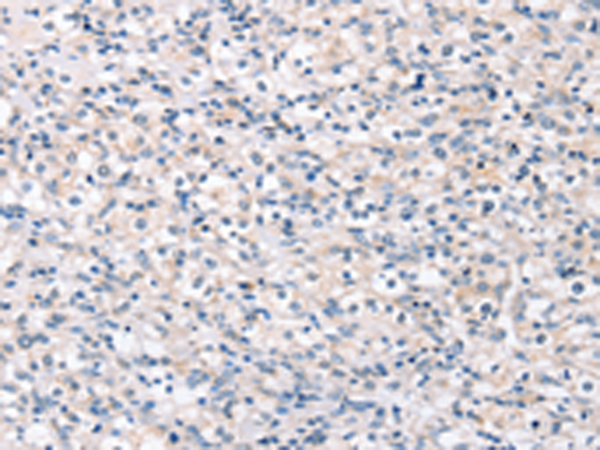

| WB | 咨询技术 | Human,Mouse,Rat |
| IF | 咨询技术 | Human,Mouse,Rat |
| IHC | 1/25-1/100 | Human,Mouse,Rat |
| ICC | 技术咨询 | Human,Mouse,Rat |
| FCM | 咨询技术 | Human,Mouse,Rat |
| Elisa | 1/2000-1/5000 | Human,Mouse,Rat |
| Aliases | NTRKR1; dJ537F10.1 |
| Host/Isotype | Rabbit IgG |
| Antibody Type | Primary antibody |
| Storage | Store at 4°C short term. Aliquot and store at -20°C long term. Avoid freeze/thaw cycles. |
| Species Reactivity | Human, Mouse |
| Immunogen | Synthetic peptide of human ROR1 |
| Formulation | Purified antibody in PBS with 0.05% sodium azide and 50% glycerol. |
+ +
以下是关于ROR1抗体的3篇参考文献及其摘要的简要概括:
1. **文献名称**:*Targeting ROR1 identifies and eliminates chronic lymphocytic leukemia stem cells*
**作者**:Kipps, T.J. 等
**摘要**:该研究报道了一种人源化单克隆抗体(如Cirmtuzumab)靶向ROR1的临床应用潜力。通过体外和动物模型实验,发现该抗体可抑制慢性淋巴细胞白血病(CLL)细胞的存活和增殖,并减少白血病干细胞活性,提示其可能通过阻断ROR1信号通路发挥抗肿瘤作用。
2. **文献名称**:*Antibody-drug conjugate targeting ROR1 suppresses tumor growth in preclinical models*
**作者**:Yamaguchi, T. 等
**摘要**:研究团队开发了一种针对ROR1的抗体药物偶联物(ADC),将细胞毒性药物与ROR1抗体结合。在乳腺癌和肺癌的临床前模型中,该ADC显示出选择性杀伤ROR1阳性肿瘤细胞的能力,显著抑制肿瘤生长,且对正常组织毒性较低。
3. **文献名称**:*Structural basis of ROR1 recognition by a bispecific antibody for cancer immunotherapy*
**作者**:Zhang, S. 等
**摘要**:该研究解析了ROR1胞外结构域与其双特异性抗体的复合物晶体结构,揭示了抗体结合的关键表位。基于此设计的双特异性抗体可同时靶向ROR1和CD3分子,在体外实验中有效激活T细胞杀伤ROR1阳性肿瘤细胞,为实体瘤免疫治疗提供了新策略。
---
**备注**:以上文献信息为示例性概括,实际研究中建议通过PubMed或专业数据库(如Nature、ScienceDirect)检索具体文章。
ROR1 (Receptor Tyrosine Kinase-Like Orphan Receptor 1) is an oncofetal protein highly expressed during embryogenesis but largely absent in healthy adult tissues. It reappears in various cancers, including chronic lymphocytic leukemia (CLL), breast cancer, lung cancer, and pancreatic cancer, making it a promising therapeutic target. ROR1 promotes tumorigenesis by regulating cell survival, proliferation, and metastasis through Wnt5a signaling and interactions with other pathways like PI3K/AKT and NF-κB.
ROR1-targeting antibodies have emerged as a key focus in cancer immunotherapy. Monoclonal antibodies (e.g., cirmtuzumab) bind to ROR1’s extracellular domain, blocking pro-survival signaling and inducing antibody-dependent cellular cytotoxicity (ADCC). Bispecific antibodies, such as those engaging CD3 or PD-1. enhance T-cell-mediated tumor killing. Additionally, ROR1-directed CAR-T cells and antibody-drug conjugates (ADCs) are under preclinical and clinical evaluation.
Early-phase trials (Phase I/II) of ROR1 antibodies show encouraging safety and efficacy, particularly in CLL and mantle cell lymphoma. Challenges include managing on-target/off-tumor toxicity due to low ROR1 expression in some normal tissues (e.g., adipocytes) and addressing resistance mechanisms. Research also explores ROR1’s role as a diagnostic biomarker and its crosstalk with tumor microenvironments.
Overall, ROR1 antibodies represent a versatile therapeutic strategy, with ongoing efforts to optimize specificity, combinatorial regimens, and patient stratification.
×